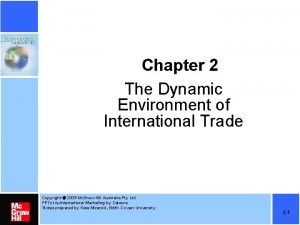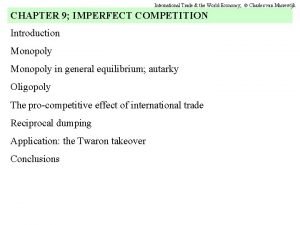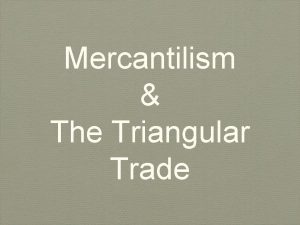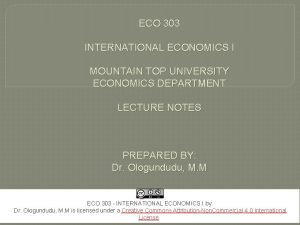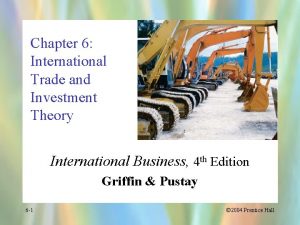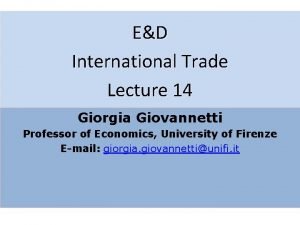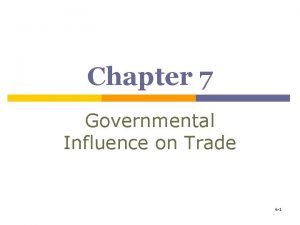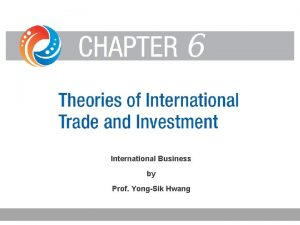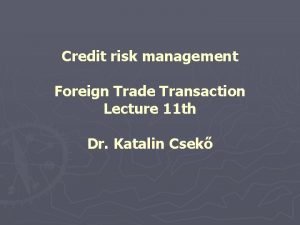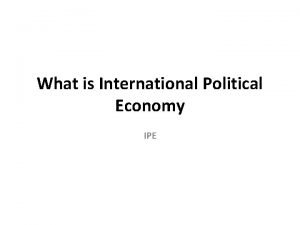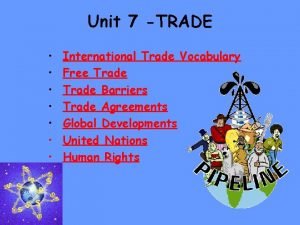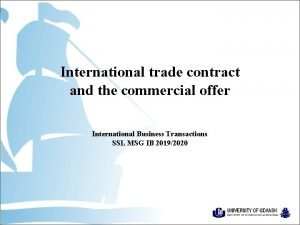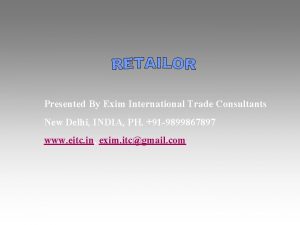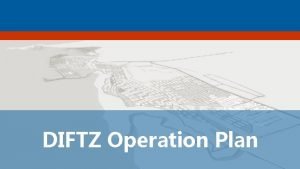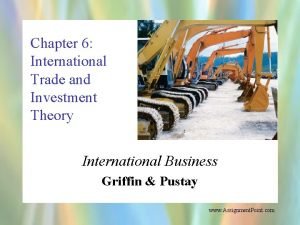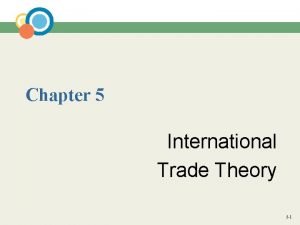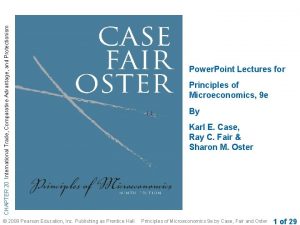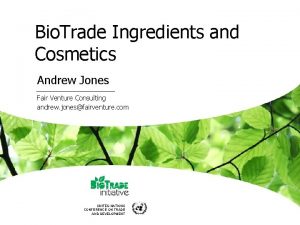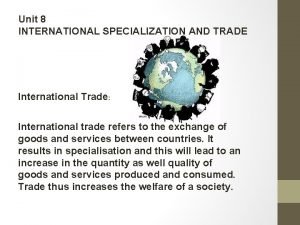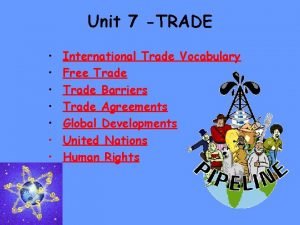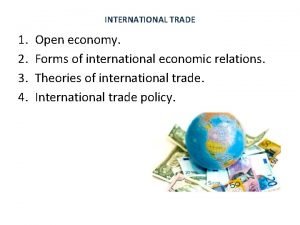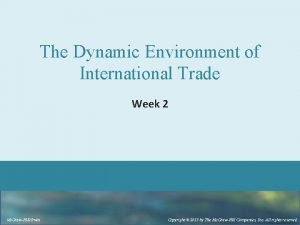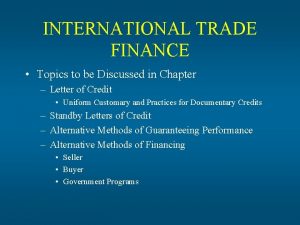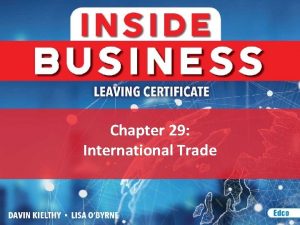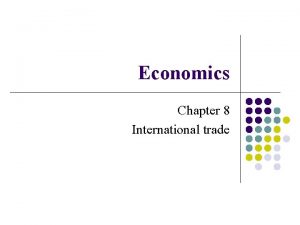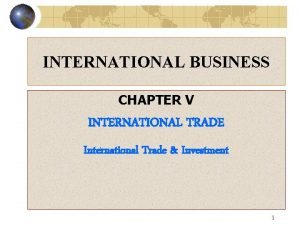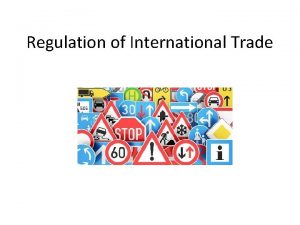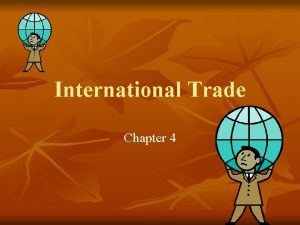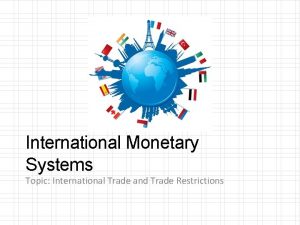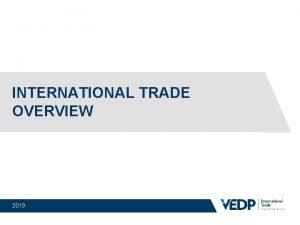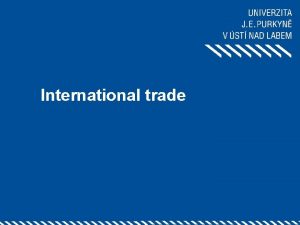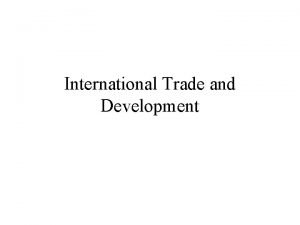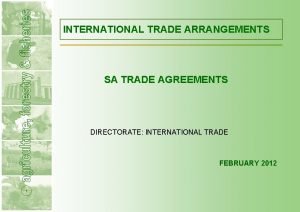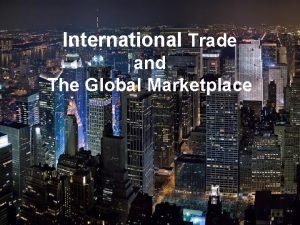International Trade What is International Trade International trade



































- Slides: 35

International Trade

What is International Trade? • International trade is the buying and selling of goods and services across international boundaries • Countries sell goods and services produced domestically to buyers abroad-- exports • Countries buy goods and services from other countries for domestic use--imports

Why have international trade? • Countries trade with each other because they get ‘gains from trade’ • An economy (or a firm) needs to decide what to produce and what to trade given the scarce resources or more specifically, its factor (resource) endowment (the quantities and quality of factors of production as well as levels of technology) (e. g. Land, natural resources, high skilled labor, technology, etc. ) • Each country has different factor endowments • concepts of absolute advantage and comparative advantage • worksheet

Modeling the Theory of Absolute Advantage ASSUMPTIONS 1) Two countries and two goods 2) Constant opportunity costs PPF is ………………… 3) Negligible transport costs • A country has an absolute advantage in a good if with the same quantity of resources, it can produce more of the good than another country. (Or one country can produce a good using fewer resources than another. ) • Theory of absolute advantage states that if countries specialize in and export the good in which they have an absolute advantage, the result is increased consumption in each country (can CONSUME beyond the ppf). All countries will be better off • (go to slide 21 OR review absolute advantage)

A PPC with constant costs • When the PPC is a straight line, opportunity costs are constant (do not change) as the economy moves from one point on the PPC to another. It occurs when the factors of production are equally suited to the production of both goods (e. g. basketball and volleyballs which are very similar, needing similar specialized factors of production)

Modeling the Theory of Absolute Advantage • Consider a very simple world economy comprised of two countries: Coffenia and Robotia, which produce coffee and robots • The following table show the quantities of coffee and robots that one worker in one day can produce in Coffenia and Robotia, if they produce only coffee or only robots

• When Coffenia only produces coffee, it can produce 8 units as shown in point A (similarly, for the other points) • Comparing the PPCs, it is evident that Coffenia has an absolute advantage in coffee, since its PPC extends further out on the coffee axis (vice versa in the case of Robotia who has a absolute advantage in robots production)

Production and Consumption in case of No Trade • Coffenia and Robotia can produce anywhere along their PPC, depending on how they allocate their scarce resources • If they decide not to trade with each other, each one produces robots and coffee themselves. • Suppose that Coffenia and Robotia spend half of their resources producing coffee and the other half on robots • The results of this can be shown as follows

• As you can see, total production of the two goods in both countries are 5. 5 units of coffee and 5 units robots • Use this autarky (no trade) result as the anchor to illustrate how trade can improve the overall production and consumption of the two goods

Production and Consumption with Trade • Suppose that both countries agree to trade and they each specialize and export the good in which they have an absolute advantage • Coffenia therefore specializes entirely in production of coffee moving to point A on its PPC and Robotia specializes entirely in the production of robots, moving to point D on its PPC

• Adding up the total production in both countries, production has increased by 2. 5 units of coffee and 1 robots • There is a clear gain in the global and overall production of the two goods (i. e. a more efficient allocation of global resources).

(continue) • Now suppose that Coffenia and Robotia agree to trade with each other a the price ratio of 1: 1 where they would trade 1 unit of coffee for 1 robot • In such case, they would agree to trade 3 units of coffee for 3 robots (Coffenia exports 3 units of coffee which Robotia imports and Robotia exports 3 robots which Coffenia imports) • This is summarized as follow


• As you can see, with trade, Coffenia consumes 5 units of coffee (8 – 3 they export) and 3 units of robots (which they import) while Robotia consumes 3 units of coffee (which they import) and 3 robots (6 – 3 they export) • Now, with respect to the PPC, this is represented with points G and H

• As you can see, where as both countries are producing on their PPC, due to trade, they can consume at a point outside their PPC! They are able to consume beyond what they could have produced themselves. Both countries are now better off with trade

To Sum: Theory of Absolute Advantage • The above analysis illustrated that both countries become better off because specialization according to absolute advantage leads to a ‘global’ reallocation of resources where production takes place by the most efficient (low cost) producers • -> page 3 of H/O

Theory of Comparative Advantage • The theory of absolute advantage explains part of gains from specialization and trade • David Ricardo (19 th centuryeconomist ) introduced the idea of comparative advantage to show that countries can gain from specialization and trade even if one country has the absolute advantage in both goods. It is only necessary that countries have different opportunity costs (relative costs) for their goods, so that the production of one good is relatively cheaper in one country than in another, even if it is not absolutely cheaper • And that the EXCHANGE RATE is …………. . • To sum, comparative advantage refers to the situation where one country has a lower opportunity cost (relative cost) in the production of a good than another country • Go over WS question (page 4)

Illustrating the Theory of Comparative Advantage • Consider a very simple world economy comprised of two countries: Cottonia and Microchippia, producing cotton and microchips • The following table show the quantities of cotton and microchips that one worker in one day (i. e. per unit of inputs) can produce if only one or the other good is produced

• As we can see, unlike the previous case, Microchippia has an absolute advantage in the production of both cotton and, because with the same resources (one workermicrochips in one day), it can produce more of both goods than Cottonia • The PPC of this case is illustrated as follows

• As you can see, unlike the previous case where the PPCs crossed, Microchippia’s PPC lies entirely above the PPC of Cottonia • The question now is should the countries still trade? If so how and which goods should each country produce?

• In order to determine whether trade is still beneficial and which goods the two countries should produce, we need to consider the opportunity cost of producing each good at the expense of other good for both countries • Recap: opportunity cost is the next best alterative forgone and sacrificed in order to obtain something. In this case, it is the production of the good that is not produced due to the production of the other good – The opportunity cost of producing cotton is the quantity of microchips that must be sacrificed to produce an extra unit of cotton (∆ microchips / ∆ cotton as you move from one point of PPC to another) – The opportunity cost of producing microchips is the quantity of cotton that must be sacrificed to produce an extra unit of microchip (∆ cotton / ∆ microchips as you move from one point of PPC to another)

• As the PPC has a constant slope, the opportunity costs are constant between the two goods throughout the PPC – There is no increasing cost and the resources are equally substitutable for the two goods • Thus, to calculate the opportunity cost of cotton, we divide the maximum number of microchips that can be produced (x intercept) by the maximum number of cotton that can be produced (y intercept) for each country • This gives the following results

Calculating the Opportunity Costs and Comparative Advantage

(continued) • Microchippia has a lower opportunity cost in producing microchips but Cottonia has a lower opportunity cost in producing cotton • In this scenario, Cottonia has a comparative (or relative) advantage in cotton production, while Microchippia has acomparative advantage in microchips • And based on the idea of comparative advantage by Ricardo, Cottonia should specialize in cotton production and export cotton and import microchips, while Microchippia should specialize in microchip production and export microchips and import cotton • But the question is how do we know this comparative advantage would lead to gains from trade for both countries? Moreover, should both countries specialize fully (100%)in producing one good as in the case when each country had an absolute advantage in one of the good?

Suppose NO specialisation & trade • If the countries do not trade and each country uses half of their resources to produce each of the goods. Cottonia produces 10 cotton and 5 microchips; Microchippia makes 12. 5 cotton and 25 microchips. • In this case, there is a total/global production of 22. 5 cotton and 30 microchips

Specialization trade • Microchippia , who has the absolute advantage in both cotton and microchips, does not fully specialize in the production of microchips. Rather, they still produce some cotton • For example……. if Microchippia spends 8/10 of their resources on microchips (total of 8/10 x 50 = 40 units of microchips) and 2/10 of their resources on cotton (total of 2/10 x 25 = 5 units of cotton) • Cottonia continues to specialize fully in the production of cotton (20 units) • The two countries then trade 10 units of both goods at the exchange rate of 1: 1 (consider why this exchange rate is beneficial to BOTH countries) • In this case, Microchippia eventually consumes 15 units of cotton and 30 units of microchips and Cottonia consumes 10 units of cotton and 10 units of microchips. Both consume outside their respective PPCs there are clear gains of trade

Summarising…. . • The theory or LAW of comparative advantage states that it is possible for all countries to gain from specialization and trade if countries SPECIALIZE according to their COMPARATIVE ADVANTAGE. The global allocation of resources improves a more efficient resource allocation and increased global output, allowing countries to consume outside their PPCs (i. e. by specializing in the production of a good (or service), an economy can use its resources more efficiently ( lower opportunity costs ). Thus it can produce more of one good and trade some of it for other goods produced more efficiently in other economies) (But in order to achieve the increase in the output of ALL goods, we must consider different extent/degree of specialization (not full specialization) of the production of the two goods, particularly by the country which has an absolute advantage in producing both of the goods)

Evaluation: Assumptions of Theory of Comparative Advantage • • • There are two countries and two goods – relaxing this assumption is OK Constant opportunity costs- problems if costs increase as production increases There are no transportation/transaction costs – there are transportation costs which will affect the real cost of the goods it is not worthwhile to trade some goods Which type of opportunity cost ratios would imply NO gains from trade Factors of production are immobile and fixed – but in reality, labor and capital do move between countries (eg within European Union) Technology is fixed – but in reality, technology is always advancing There is full employment of resources (as illustrated on PPC) – not true in reality Imports and exports balance each other – but in reality there are imbalances in trade (trade deficits and surpluses) Other criticisms (not assumptions): – Specialization according to Comparative Advantage may lead to too much specialization which can make the country more vulnerable to economic fluctuations e. g. world food prices effect economically less developed countries (ELDCs) which specialize in agriculture. – Specialization may also hinder economic development as the economic structure does not evolve from agriculture manufacturing service

Gains from FREE trade: 1) Specialization according to COMPARATIVE ADVANTAGE: more efficient resource allocation. Global production and consumption will increase + 2) Economies of scale: exporting firms produce more output and invest in methods which will achieve economies of scale to lower costs and prices for consumers • + 3) Increased competition (the car industry in Japan is oligopolistic, but closer to monopolistic competition globally) lower prices, increased choice for consumers etc • 4) Acquiring needed resources: countries may need natural resources or capital goods that are not available domestically e. g. oil for Japan

‘gains from trade’ (continued) • 5) Flow of new ideas and technology: new ideas, technologies, skills, etc. can be transferred from one country to another • Trade as an engine for economic growth: specialization, economies of scale, increased competition, acquisition of needed resources, technological advances, etc. will all contribute toward increases in domestic output • Advantages of FREE TRADE

World Trade Organization • World Trade Organization – is an international government organization (like the UN) which provides an institutional and legal framework for the trading system that exists between nations worldwide • It is an advocate for liberalizing trade (free trade) • It suggests and monitors trade rules, provides a forum for trade negotiations, and settles trade disputes between MEMBER countries

World Trade Organization • https: //www. wto. org/index. htm

Modelling the advantages of FREE TRADE with a world (or international price) • Cottonia’s domestic market for cotton is shown below using the usual demand supply curves • The question of whether or not Cottonia should trade cotton with the world depends on whether or not they have a comparative advantage in producing cotton. This can be analyzed through looking at whether the domestic price of cotton is lower or higher than the world price of cotton

(continued) • Suppose Cottonia’s cotton market is small compared to the global market, so that its buying and selling activities do not have the ability to affect the world price • This means that the world supply of cotton facing Cottonia is …………………, appearing as ……………. . Cottonia can sell or buy any quantities of cotton at the world price • This is shown as follows… •

Welfare gains from trade (Handout Page 7 and Last Page Q 1) • Show the world supply curve, assuming Cottonia has a comparative DISADVANTAGE • Show imports with free trade • Show changes in consumer surplus, producer surplus and community surplus
 Trade diversion and trade creation
Trade diversion and trade creation Fair trade not free trade
Fair trade not free trade Trade diversion and trade creation
Trade diversion and trade creation Trade diversion and trade creation
Trade diversion and trade creation Which is the most enduring free trade area in the world?
Which is the most enduring free trade area in the world? Liner shipping and tramp shipping
Liner shipping and tramp shipping The trade in the trade-to-gdp ratio
The trade in the trade-to-gdp ratio Ted talk atlantic slave trade
Ted talk atlantic slave trade Dynamic environment of international trade
Dynamic environment of international trade International trade
International trade Mercantilism theory of international trade
Mercantilism theory of international trade Modern trends of foreign trade in india
Modern trends of foreign trade in india Explain kravis and linder theory.
Explain kravis and linder theory. Chapter 6 - theories of international trade and investment
Chapter 6 - theories of international trade and investment International trade
International trade Essential industry argument
Essential industry argument Theories of international trade and investment
Theories of international trade and investment Credit risk in international trade
Credit risk in international trade What is ipe
What is ipe Vocabulary international trade
Vocabulary international trade Certificate in international trade and finance citf
Certificate in international trade and finance citf International trade contract
International trade contract Exim international trade consultants
Exim international trade consultants Current theory of international trade adalah
Current theory of international trade adalah Djibouti international free trade zone
Djibouti international free trade zone Firm based trade theory
Firm based trade theory Product life cycle theory of international trade
Product life cycle theory of international trade International trade
International trade Trade ingredients
Trade ingredients Specialization in international trade
Specialization in international trade Vocabulary unit 7
Vocabulary unit 7 International trade defination
International trade defination What is international trade
What is international trade Dynamic environment of international trade
Dynamic environment of international trade Strategic trade theory
Strategic trade theory International trade and finance topics
International trade and finance topics








